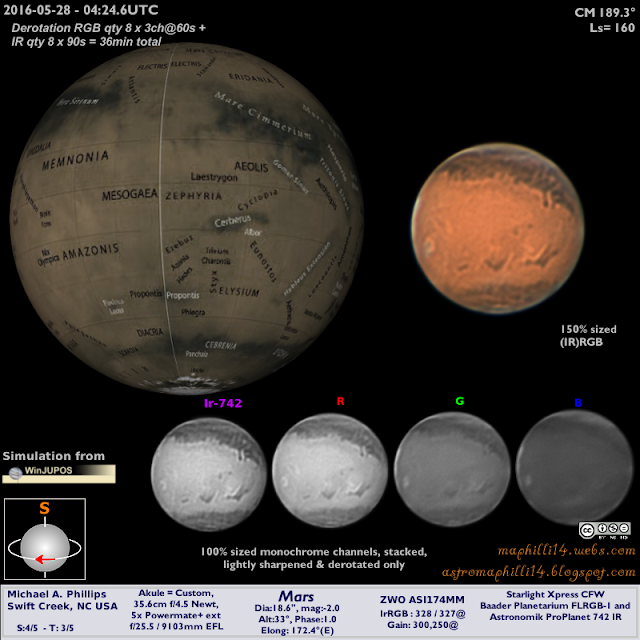Since Mars only makes a good appearance every other year, I tend to get a bit crazy when it comes around. This season was pretty cloudy and rainy but from June 7th to the 13th I had a personal record 7 days outside with the scope. I'll try to give you a quick review of the weather for each image as well as my favorite aspects of each.
On the 6/7th TS Colin FLEW across NC leaving in the morning. That evening had poor transparency with some high winds aloft and many small passing clouds. This only netted me a single good image... My favorite thing about day 1's image is seeing Valles Marineris: The Grand Canyon of Mars (
http://www.nasa.gov/multimedia/imagegallery/image_feature_83.html)
By the 2nd night out, the 8th, the seeing was best for the week, 4/5 and nearly perfect 5/5 transparency. There was some rapid cooling but also VERY dry. My favorite thing about this image is the peak of Olympus Mons poking out of the morning haze!
The 3rd day, June 9th, was fairly average 3/5 and hazy clouds early. My favorite thing about this nights image are the frilly spikes around the Xanthe region in the middle. It's always so varied and fun to stare at!
On the 10th, or 4th night out, I shot in some above average conditions. I think I was lucky as I lured my fellow Triangle observer,
+Tim Jensen out and he had some bad clouds whereas I didn't, go figure. My favorite thing about this night's image was getting Sinus Meridiani (
https://en.wikipedia.org/wiki/Sinus_Meridiani)
On the 11th, or 5th night out, I started to get a bit weary and the conditions didn't get much better with the seeing mostly average and just average transparency. Much warmer than previous nights, but still a 'sleep with the windows open' night! My favorite thing about this image is the strong contrast around Sinus Meridiani and the small morning clouds around the Tharsis region.
Night 6 was June 12th and saw much warmer, windier conditions and below average conditions. I was still able to eek out a decent image using the higher frame rates of my AS174MM camera! While not much to look at compared to the previous ones, my favorite thing about this image is the stark plains of Arabia in the lower left area.
The 7th day, June 13th jumped up in seeing quite a bit, perhaps due to an oncoming front, I don't know why. Seeing was about 3.5/5 and the clouds were murky with rapid cooling but clear and nearly steady at moments! I only was able to get a single image with no derotation, but my favorite two things in this image are the dark Syrtis Major on the upper right limb, just about to set into the evening darkness and the clouds over Mare Acidalium (
https://en.wikipedia.org/wiki/Mare_Acidalium_quadrangle)
Thank you for taking the time to read all my details and I hope you enjoyed my week long tour as much as I did!
For details on my telescope please ask
+Akule
For capture details please look here and I will be releasing major updates soon, so please come back!
If you really can't get enough I made the previous season's photos into a mug:
and a few others into various things like iPhone covers and pillows over at redbubble:


















